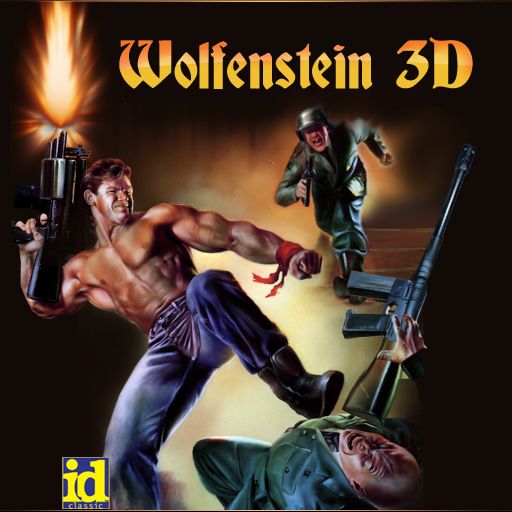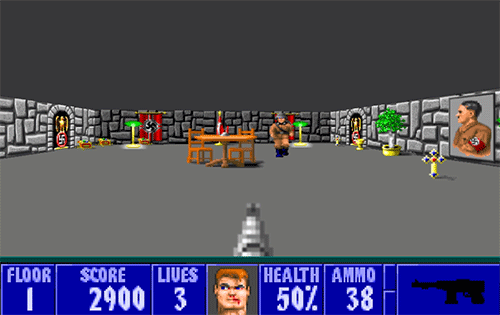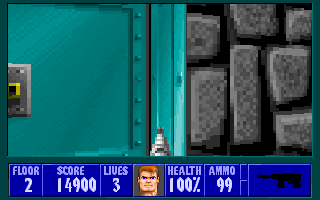Original Console: MS-DOS
Original Release Date: May 5, 1992
Developer: id Software
Plot: The year is 1945, and World War II is nearing its conclusion, but not before the Nazis enact several plans to defeat the Allied Powers once and for all. William "B.J." Blaskowicz, an American agent well-versed in espionage, is captured by the Germans and taken prisoner in Castle Wolfenstein. For 12 days he is tortured relentlessly until he finds his opportunity. He kills the man guarding him, steals his pistol, and now looks to escape the castle alive. There is no time to hesitate for BJ. He knows that if he waits, the Nazis will come crawling out of the woodwork to make sure he is silenced. It is just him and this gun, and the army of evil awaiting him.
84/100
Gameplay: The story of Wolfenstein 3D begins with four men, and the founding of a small-time Texas-based game company. John Carmack was a young up-and-coming genius of technological design; having dropped out of the University of Missouri-Kansas City to become a freelance developer, Carmack was known for being able to utilize technology to create better-looking games. As a teenager, Carmack's intelligence was scarily apparent when he and some friends invented Thermite to break into the school's computer lab to borrow the newest computer. Having brought this "can-do" attitude to adulthood, Carmack looked to innovate in the world of gaming. It was during the freelance work that he met John Romero.
Romero's story was not unlike John Carmack, but with a passion for design and gameplay rather than technology. Romero designed several independent games through the late 1980s before Carmack hired him for SoftDisk in mid-1989. Romero was responsible alone for several game ports such as Space Rogue, Might & Magic II, Tower Toppler, and even Dark Castle. However dissatisfied with the working situation at SoftDisk, John Romero and John Carmack sought independence to eke out their own creative mark on the gaming world. They left SoftDisk in 1991, and started the company that would be known worldwide as "id Software".
Adrian Carmack during the 1980s had floundered in the gaming industry as an artist for several independent game companies before his talents were spotted by John Carmack (no relation). John invited Carmack to join them in the formation of id Software and it was through his design and art that the future art style of several games was secure and made iconic. Tom Hall was a relatively unknown designer and creative writer, John Carmack however saw potential in the young man, and was insistent on making Hall the new creative director for id Software. Tom Hall utilized experimental gameplay ideas and wished for games that pushed the limits of creativity.

The four of these men began work on their own new company, releasing several games that innovated the platformer action genre on the personal computer: Commander Keen. Platformers on PC were a slow affair, but thanks to John Carmack conveniently inventing what became known as "Adaptive Tile Refresh", the genre had smoothed out framerates and lowered memory usage on the software. id Software had just made their first major mark on computer gaming, but it would not be their greatest.
Games from the first-person perspective had existed since the early 1980s. Battlezone from 1980 was a tank simulator that was played in the first-person, though through line-art and polygonal interfaces. By the late 80s, there had been some refinement in the techniques for these first-person games, in the form of MIDI Maze, a multiplayer shooter that utilized a MIDI interface within the Atari ST home computer. John Carmack, seeing potential in non-Atari computer games, worked to utilize “Ray Casting”, a technique by which 3D objects are seemingly projected onto a singular plane via algorithmic techniques. This was first demonstrated by id Software’s Hover Tank 3D, which was released in April of 1991.
Hover Tank 3D was extremely basic, however, as walls and floors were basic colors, and sprites of enemies were not nearly as detailed as projected. Regardless, the game was considered a success, and a technological leap forward in innovating first-person action games. id Software’s next major release would see further development of the ray casting technique, but not without a little inspiration from Blue Sky Productions (later renamed Looking Glass); it had been learned that Blue Sky Productions was developing the next Ultima game, known as Ultima Underworld: The Stygian Abyss. During its production, John Carmack and John Romero had seen the tech demo for the game; most notably, they were impressed by the texture-mapped visuals of the game, by which the walls and even floors were given texture. In a conversation with designers Paul Neurath and Doug Church, Carmack quipped that he could build a texture-mapping engine faster than Ultima Underworld’s release. What may have been a funny anecdote was later proven true, as Carmack developed a texture-mapping engine for their next release by November of 1991, while Ultima Underworld was released in March of 1992. This release would become Catacombs 3-D.

Catacombs 3-D would be the third in Carmack’s Catacombs series and would prove to be yet another leap forward in the technological advancement of the first-person genre. Catacombs 3-D was another big success. However, John Romero wanted to create a more modern game, without magic or fantastical elements. Romero wished to bring back a game series from his childhood: Castle Wolfenstein. Castle Wolfenstein was a 1981 Apple II stealth shooter developed by Silas Warner. The game was about a spy sneaking into and disrupting the Nazi war effort in a castle known as Wolfenstein. It was among the earliest games that utilized a stealth mechanic for its gameplay and was a heavy favorite for the young Romero. A sequel, called Return to Castle Wolfenstein, was released the year afterward, which further aided the stealth mechanics by allowing the player to steal uniforms and passes from dead Nazi officers and soldiers. The most striking feature of the early Wolfenstein games was the utilization of “voices”’: heavily bit-crushed computer voices inspired by Berzerk. When id Software had learned that Muse Software, the developers of the game, had gone bankrupt and lost the rights to Wolfenstein, they immediately bought up the name and would market their next project as Wolfenstein 3D.
As development rolled along, John Romero and Tom Hall discovered that the stealth mechanics of the early Wolfenstein games had slowed down the pacing of their project tremendously, leading to a bloated and overall unsatisfying product. The id Software personnel made the decision to remove the stealth mechanics entirely, lending to the general agreement that stealth wasn’t what made the game fun; it was the fast-paced action and hard-nosed shoot-em-up quality to the game that was more endearing. With this new ideology in mind, id Software released Wolfenstein 3D as a share-ware game on May 5, 1992, for DOS. When id Software showed their project to Silas Warner, the original designer of Castle Wolfenstein and its sequel, he was proud of it, considering it a worthy successor to his original games. It was a rapid success, rocketing id Software to the top of the computer gaming stratosphere. A game like this had never come before, and by late 1993, Wolf 3D had sold nearly 200,000 copies. Indeed, it was the first of its kind; Wolfenstein 3D was the progenitor of the “First-Person Shooter”.
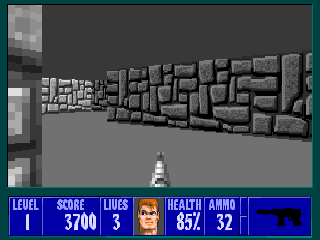
Wolfenstein 3D is a first-person shooter game that is a unique experience all of its own. A little primitive by 2021 standards, but nonetheless it’s aged fairly well for itself (depending on the source port you’re using nowadays). The game itself is fairly simple, you run and shoot Nazis in maze-like levels while trying to avoid getting slaughtered yourself. I find that this simple philosophy makes it easy to dive into and really get your hands dirty with Nazi blood and guts. Level design is rather simplistic and depending on which episode you’re on, can be incredibly confusing. The weaponry and enemies are rather iconic as well, having their own innate charm.
You start with a pistol, a simple little item that in a jam is your best friend. It uses one bullet at a time and can take out most of the weakest enemies. Losing all your ammo leaves you with the knife, a desperate call to action that leaves you open to death via the strongest enemies, but can serve to get you a pack of ammo in a pinch. The machine gun is your bread-and-butter weapon packing a wallop and running through most enemies with ease. It fires quickly and only uses one bullet per fire. If you’re lucky, you might find the chaingun though; the ultimate in dealing death to Nazi scum. The chaingun is big, bad, powerful, and runs through both Nazis and ammo like a dog to food. It uses two bullets per shot and it fires very fast; it’s best to use only when absolutely necessary, or when facing a boss or hordes.
What are weapons without enemies to slaughter? From the lowliest to the biggest baddies, the Nazi Party is throwing everything it’s got at BJ Blaskowicz to make sure he’s dead meat. The lowly Guard is commonplace on many maps, simple pistol-wielding baddies that can be disposed of quickly, and drop much-needed ammo. Pet dogs are vicious brutes, but they can be gotten rid of fairly easily, a single shot is all you need. The Nazi Schutzstaffel are beefier boys, armed with a machine gun and ready to dole out damage whenever they can; they’re far more dangerous in higher numbers and will whittle the player to nothing but dust if given a fair opportunity. Then there are the mutant monsters of Doctor Schabbs, humanoid mutations packed with a rifle in their chest; they are silent but deadly. Upon awakening, they do not make a noise until they are firing at the player, giving them the opportunity to ambush the player and dispose of them post-haste. They are arguably the most dangerous enemy in the game. Finally, of all base enemies, the Officer is the creme de creme; fast as a rabbit, quick to the draw, and deadly accurate, they are dangerous foes when in compilation with other compatriots, but by themselves can be killed off rather easily. A truly mesmerizing menagerie of Nazis, all to be killed by BJ Blaskowicz.
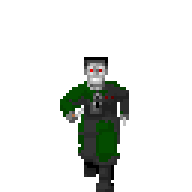
Though the base enemy listing is fairly scant, it’s all one needs to have fun slaughtering Nazi after Nazi; and frankly, it’s sort of that simplistic game design that I actually enjoy. Sure, the objective is to get to the end of the level, but that doesn’t mean it’s so basic that it isn’t fun. There’s more to it than that.
Wolfenstein 3D runs on an episodic share-ware format, where the first set of 10 levels is free-to-play, and the player may choose to pay to play the rest of the game. The first episode “Escape From Castle Wolfenstein”, is the shareware episode that serves as an introduction to the series; escaping from the titular Castle Wolfenstein, BJ Blaskowicz comes across his most infamous of foes: Hans Grösse. The second episode, “Operation Eisenfaust”, introduces the mutant soldiers and their creator, Dr. Schabbs. The most infamous episode, “Die, Fuhrer, Die”, allows BJ Blaskowicz to storm the bunker in Berlin Germany to assassinate the ultimate evil: Adolf Hitler himself. There are an additional three episodes, depending on the version of Wolfenstein 3D you have, you will also have the Nocturnal Missions, a prequel pack that is one long storyline about disrupting a Nazi chemical warfare scheme.
The difficulty settings for Wolfenstein 3D are just as iconic as the rest of the game. Four difficulties for the player to choose from, each raising the bar through their name. The first difficulty setting is the aptly named “Can I Play, Daddy?”, an easy mode where enemies are in lesser numbers and weaker. “Don’t Hurt Me”, is only slightly harder than the former, but can bring a challenge to newer players. “Bring ‘em On!” serves as the default difficulty of Wolfenstein 3D, with enemies standing rough and ready to dispose of the player. If you’re feeling dangerous though, there is the hardest difficulty: “I am Death Incarnate!”; even the lowliest enemies can kill the player in only a few shots, and they are in massive numbers.
Wolfenstein 3D nonetheless has a gameplay style that has aged fairly well all things considered. It never gets old killing enemy after enemy, and despite the maze-like structures, only a few levels are truly annoying and not very fun. I mean, it doesn’t really get any better than killing Adolf Hitler.
82/100
Visuals: Visually speaking, Wolfenstein 3D hasn’t aged poorly in that department either, though it certainly isn’t great looking nowadays. The character sprites are finely designed, especially by early-1990s standards; the environments are somewhat outdated, though still serviceable. There’s not much to talk about, other than the fact the ray cast engine works fairly well, despite its clear limitations of floor height, ceiling height, and wall textures. Level design is a mixed bag here and there, and there’s a surplus of levels that are designed to be the Nazi swastika; so there is that.
76/100
Audio: Wolfenstein 3D has some solid music and audio cues. Soldiers speak in broken German, highlighted as a stereotype of the Nazi, and their cries of death are rather satisfying. The Schutzstaffel’s cries of “Mein Leben!” are great to hear as they drop. Not to mention the music in Wolfenstein 3D is classic and very memorable. The opening theme (and additionally a song for some levels) is a rendition of the Nazi anthem, “Horst Wessel Leid”. This doesn’t serve to glorify the Nazi party at all, despite what some people think. The backdrop of the Nazi national anthem being played whilst Nazis are slaughtered by a Jewish-American soldier of Polish descent is not exactly glorifying them, is it? Other of my personal favorite songs for Wolfenstein 3D are “Searching For the Enemy”, “P.O.W.”, “Zero Hour”, and “Wondering About My Loved Ones”. Absolutely worth having a listen to on your downtime. There’s overall a great mix of pulse-pounding tracks and atmospheric ambiance that brings the tension to life, all thanks to Bobby Prince, the wonderful composer for id Software.
79/100
Final Thoughts: Wolfenstein 3D, despite being nearly 30 years old, still plays tremendously well. It never gets old sitting back and slaughtering Nazi after Nazi, and hell, killing Hitler is the pinnacle of gaming honestly. If you’re looking to seek the origin of the First-Person Shooter, then look no further than here.
Final Rating: 80/100














